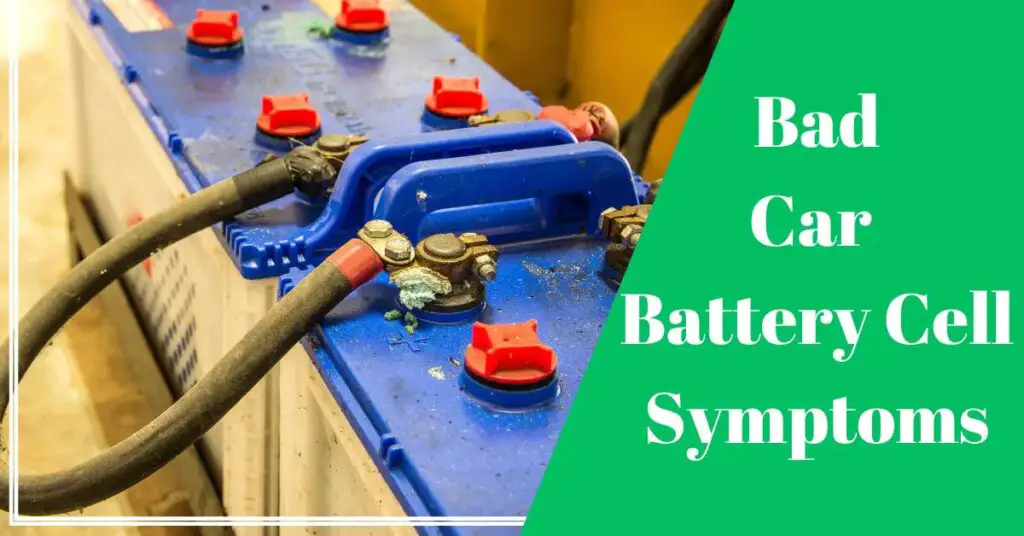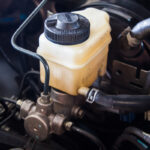Did you know that a sluggish start or flickering lights could point to a bad cell in your car battery? And other bad cell in car battery symptoms?
In this guide, we’ll unravel the mystery of bad battery cells. Discover telltale signs, learn whether repair or replacement is the way to go, and explore savvy maintenance tricks.
Get ready to rev up your knowledge and ensure your ride never gets stalled. Let’s dive in!”
Table of Contents
What is Car Battery Health?
A car battery is a critical component of a vehicle’s electrical system, providing the necessary power to start the engine, run various electrical systems, and maintain overall vehicle functionality. Maintaining a healthy car battery is essential for reliable and efficient vehicle operation. A healthy battery ensures proper starting power, efficient charging of accessories, and longevity of the battery itself.
Importance of a Healthy Car Battery
- Starting Power: A healthy battery provides the initial power required to start the engine. If the battery is weak or depleted, it can lead to difficulty or failure in starting the vehicle.
- Electrical System Stability: The car’s electrical systems, such as lights, radio, air conditioning, and power windows, rely on a stable power supply. A weak battery can result in flickering lights or reduced performance of these systems.
- Charging System Support: The battery plays a crucial role in the vehicle’s charging system. It stores excess electrical energy generated by the alternator and releases it when the demand exceeds the alternator’s output.
- Preventing Strain on Alternator: A healthy battery reduces the load on the alternator, extending its lifespan and improving overall fuel efficiency.
Role of Individual Cells in a Car Battery
A typical car battery consists of six individual cells, each contributing around 2.1 volts, for a total of approximately 12.6 volts. These cells are connected in series to achieve the required voltage for vehicle operation. The cells contain a combination of lead plates and an electrolyte solution (usually sulfuric acid), which undergo chemical reactions to produce electrical energy.
What is a Battery Bad Cell?
A bad cell refers to one of the individual cells within a car battery that has deteriorated or failed, causing an imbalance in the overall battery voltage. When one or more cells go bad, the battery’s capacity and performance are compromised.
Common Causes of Bad Cells in Car Battery
Several factors can contribute to the development of bad cells in a car battery:
Sulfation
Over time, lead-acid batteries can develop a buildup of sulfate crystals on the lead plates. This can reduce the plate’s effectiveness in generating electricity and lead to a decrease in cell performance.
Internal Short Circuits
Short circuits within a cell can lead to reduced capacity and voltage imbalances. These short circuits can occur due to plate deterioration, physical damage, or manufacturing defects.
Overcharging or Undercharging
Improper charging can lead to the formation of lead sulfate crystals on the plates, affecting cell performance and overall battery health.
Physical Damage
Vibrations, impacts, or excessive heat can damage the internal structure of battery cells, leading to reduced capacity and performance.
Age and Wear
Over time, the chemical reactions within the cells can cause gradual degradation of the plates and electrolyte, resulting in diminished cell performance.
Understanding the importance of a healthy car battery and the role of individual cells is crucial for maintaining reliable vehicle operation. Regular maintenance, proper charging practices, and monitoring for signs of bad cells can help extend the life of your car battery and ensure optimal performance.
Common Bad Cell in Car Battery Symptoms
Detecting a bad cell in your car battery is important to ensure timely replacement and prevent further damage. Here are some common signs that may indicate a bad cell:
Diminished Cranking Power
- Slow or Hesitant Engine Start: If your engine takes longer than usual to start or cranks slowly, it could indicate a weakened battery cell unable to provide sufficient power to start the engine.
- Clicking Sound While Starting: A repetitive clicking sound when you turn the key could indicate a weak cell unable to deliver the required starting power.
Low Voltage and Electrical Issues:
- Dimming Headlights and Interior Lights: If your headlights and interior lights appear dimmer than usual, it could be a sign of a bad cell affecting the overall battery voltage.
- Electrical Malfunctions: Malfunctions in various electrical systems, such as the radio, power windows, or other accessories, can result from insufficient power supply due to a bad cell.
Swollen or Bulging Battery Case
- Visual Inspection for Deformities: If you notice that the battery case appears swollen, bulging, or distorted, it could indicate internal issues, including a bad cell.
- Importance of Addressing Swelling Promptly: A swollen battery case can indicate a potentially hazardous situation. Addressing it promptly is crucial to avoid safety risks and prevent further damage.
Acid Leakage
- Corrosion Around Battery Terminals: Excessive corrosion around the battery terminals could be a sign of acid leakage, which might be caused by a damaged cell.
- Damage to Surrounding Components: Acid leakage can corrode surrounding components, leading to further electrical and mechanical issues.
Rapid Discharge and Jump-Starts
- Frequent Need for Jump-Starts: If you find yourself needing to jump-start your vehicle frequently, it could indicate a bad cell that is unable to hold a charge.
- Battery Not Holding a Charge: If your battery consistently loses its charge even after recharging, it suggests that one or more cells are not functioning properly.
If you observe any of these signs, it’s advisable to have your battery and vehicle inspected by a professional mechanic. They can perform diagnostic tests to determine the health of your battery and identify whether a bad cell is the cause of the issues. Timely replacement of a battery with a bad cell will help ensure your vehicle’s reliability and prevent potential breakdowns.
Testing and Confirming a Bad Cell
Using a Multimeter
Step-by-Step Guide to Testing Each Cell: To test each cell, follow these steps:
- Set the multimeter to DC voltage mode and a suitable range (often 20V).
- Touch the positive (red) probe to the positive terminal of the first cell and the negative (black) probe to the negative terminal.
- Note the voltage reading and repeat this process for each cell.
- Interpreting Multimeter Readings: A healthy cell should read around 2.1 volts. If you find a significant difference in voltage readings between cells, it could indicate a bad cell.
Professional Diagnostic Tools
- Advanced Testing Options: Professional mechanics have access to specialized battery testers that provide more detailed information about the health of individual cells, overall battery capacity, and other parameters.
- Seeking Assistance from Mechanics: If you’re unsure about performing tests yourself or want a comprehensive analysis, visiting a mechanic or an automotive service center is recommended.
Dealing with a Bad Cell: Repair or Replace?
Attempting Cell Revival
- Desulfation Process: Desulfation involves using a battery charger with a desulfating mode or a specialized desulfator device to break down sulfate crystals on the lead plates. This process may help revive a slightly weakened cell.
- Risks and Limitations: Desulfation might not be effective for severe cell damage, and attempting it incorrectly can further damage the battery. It’s best suited for preventive maintenance rather than repairing a heavily damaged cell.
When Replacement is Necessary
- Irreversible Damage: If a cell is significantly damaged, desulfation or other revival methods may not work. Cells with physical damage or severe deterioration are unlikely to be fully restored.
- Opting for a New Battery: In most cases, when a bad cell is confirmed, it’s advisable to replace the entire battery. This ensures reliable performance and avoids potential safety hazards.
When dealing with a bad cell, safety is paramount. Batteries contain hazardous materials, so exercise caution and follow proper safety guidelines when attempting tests or repairs.
Preventive Measures for Battery Health
Taking proactive steps to maintain your car battery can significantly extend its lifespan and help prevent issues like bad cells. Here are some preventive measures to ensure battery health:
Regular Maintenance
- Cleaning Terminals and Connections: Over time, corrosion can accumulate on battery terminals and connections, leading to poor electrical conductivity. Regularly clean the terminals with a mixture of baking soda and water, and ensure they are tightly secured.
- Keeping Battery Secure: Vibrations from driving can cause the battery to shift and potentially damage its internal components. Make sure the battery is securely fastened in its mounting bracket to reduce the risk of physical damage.
Temperature Management
- Impact of Extreme Temperatures: Both hot and cold temperatures can affect battery performance. Cold weather reduces a battery’s capacity to deliver power, while hot weather accelerates internal chemical reactions, potentially leading to water loss and plate damage.
- Using Insulation or Heat Shields: During extreme weather conditions, you can use battery insulation or heat shields to regulate temperature and protect the battery. These accessories help maintain a more stable operating temperature.
Proper Charging
- Avoid Overcharging: Overcharging a battery can lead to excessive heat and accelerated plate deterioration. Use a suitable charger and avoid leaving the battery connected to a charger for extended periods.
- Prevent Undercharging: Regularly drive your vehicle or use a battery maintainer to prevent the battery from discharging excessively. Prolonged periods of inactivity can lead to sulfation and reduced battery capacity.
Avoid Short Trips
Frequent short trips can prevent the battery from fully charging, leading to sulfation and reduced performance. Whenever possible, take longer drives to allow the alternator to recharge the battery fully.
Disconnect Accessories
When your vehicle is parked, turn off all electrical accessories such as lights, radio, and air conditioning to reduce unnecessary battery drain.
Battery Inspections
Regularly inspect your battery for signs of damage, leakage, or swelling. Address any issues promptly to prevent further damage.
Use Quality Batteries
When it’s time to replace your battery, invest in a high-quality battery from a reputable manufacturer. Quality batteries are less likely to develop problems and tend to have longer lifespans.
Routine Checks
Make it a habit to check your battery’s voltage and overall health using a multimeter. This can help you catch any potential issues before they escalate.
Frequently Asked Questions
How can I tell if my car battery has a bad cell?
Signs of a bad cell include slow engine cranking, dimming lights, frequent need for jump-starts, and a battery not holding a charge. Testing individual cells with a multimeter can confirm the presence of a bad cell.
Can a bad cell be repaired, or should I replace the entire battery?
A slightly weakened cell might be revived through desulfation. However, severe damage usually requires battery replacement to ensure safety and reliability.
What causes a cell in a car battery to go bad?
Causes include sulfation, overcharging, physical damage, undercharging, and internal short circuits due to manufacturing defects or wear and tear.
Is it safe to continue driving with a car battery that has a bad cell?
It’s not recommended, as a bad cell can lead to unreliable starting and potential breakdowns. Address the issue promptly to avoid getting stranded.
Will a bad cell affect the performance of my vehicle’s electrical components?
Yes, a bad cell can lead to dimming lights, electrical malfunctions, and reduced performance of various vehicle systems.
Can extreme weather conditions contribute to the formation of bad cells?
Yes, extreme temperatures (both hot and cold) can accelerate battery degradation and contribute to the formation of bad cells.
Are there DIY methods to revive a bad cell in a car battery?
Desulfation is a DIY method to attempt, but it’s not guaranteed to work for severe cell damage. It’s best for preventive maintenance.
How often should I check my car battery for potential issues?
Regularly inspect your battery during routine maintenance, and pay attention to signs of battery trouble like slow starting or dimming lights.
Is it necessary to buy a brand-new battery if only one cell is bad?
In most cases, yes. Replacing the entire battery ensures consistent performance and avoids potential complications from mismatched cells.
What professional tools are used to diagnose a bad cell in a car battery?
Mechanics use specialized battery testers to assess individual cell health, overall battery capacity, and other parameters, providing more detailed insights than a standard multimeter.
Maintaining a healthy car battery is crucial for reliable vehicle performance. Identifying the symptoms of a bad cell and understanding how to address the issue can help you avoid unexpected breakdowns and ensure your car’s electrical systems operate smoothly.
Regular maintenance, proper testing, and timely action are key to maximizing the lifespan of your car battery and enjoying worry-free driving.
Need car battery replacement? Find yours HERE!
Hi there! I’m Naomi O’Colman. I’ve got years of experience working at an auto repair shop here in Texas under my belt. On top of that, ever since I was a kid I’ve been passionate about the auto industry. Since I’ve joined the team at automotivegearz.com I’ve been enthusiastically sharing my passion and insights with my readers. I’m dedicated to delivering high quality content and helping you stay up to date with the latest automotive trends and products out there!







